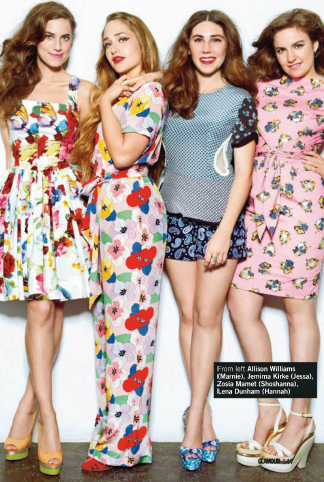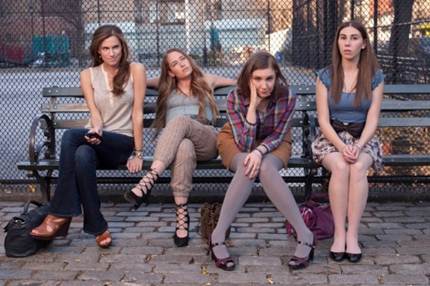It might have a small title, but our new TV
obsession is making huge waves, says Hadley Freeman
“Cool and clever”, “simultaneously
attractive and off putting”, “too white”, “grotesque and unpleasurable”. When
HBO’s smash hit Girls hit US screens this April, these were just a few of the
things reviewers had to say. And while they couldn’t seem to agree on whether
it made women look good, bad, or both at the same time, they still can’t stop debating
its role in the TV canon.

From
left: Allison Williams (Marnie), Jemima Kirle (Jessa), Zosia Mamet (Shoshanna),
Lena Dunham (Hannah)
Do you think I’m SATC-y?
No TV show since Sex and the City has
provoked so much discussion in the media, online and among viewers about women,
sex, women and sex and, finally, the representation of women on TV today. Given
that Girls is about four female friends living in New York, fumbling their way
through job crises, money panics and, of course, romantic disasters, the Sex
and the City associations have been inevitable and were, to a certain extent,
courted. The show’s writer, producer and star, the astonishingly precocious
26-year-old Lena Dunham, has said that she “reveres” SATC, and that the Girls
set-up pays homage to that show.
But in more important ways, the two shows are
so different that any comparisons seem shallower than a Casmo.
Perfectly flawed
Co-produced by Judd Apatow, better known
for making boy heavy Bromances, Girls is intelligent, witty and brutally honest
about the relations between women and men in a way Sex and the City, with all
its high-sheen gloss, never could be. While it is now a cliché for leading
ladies to be depicted as, say, charmingly klutzy in order to garner audience
sympathy (while always being gorgeous), the Girls are all deeply fallible.
Leading lady Hannah (Dunham) is selfish, narcissistic and obsessed with Adam,
an actor/ artist, but, as he points out, “You never ask anything about me you
only ask what I think of your skirt…” (personally, that moment sparked a shiver
of recognition). Marnie (Allison Williams) stays in a relationship longer than
she should because she’s too scared to do the breaking up; Shoshanna (Zosia
Mamet) is obsessed with losing her virginity; and Jessa (Jemima Kirke) causes
fights at parties. These are all things that we’ve seen onscreen before, but
from male characters, not girls.
Normality bites
The show has come in for some stick for not
featuring any non-Caucasian characters and, while that is true, one has to
wonder if the critics had ever seen an American comedy before, seeing as
they’re almost always racially homogenous (I don’t recall any non-Caucasian
main characters in Friends, say, let alone Sex and the City). That doesn’t make
it right and, yes, it does need to change, but it’s hard not to suspect that
this was just an easy stick with which to beat Dunham for being young and
successful.

The tidal wave of reviewer praise for the foul new HBO show Girls
Aside from Girls, Dunham has already
written, directed and starred in the excellent award-winning film Tiny
Furniture, in which she wandered about in various states of undress. She amps
that up tenfold in Girls. Nothing remarkable about seeing a half-naked twenty something
on screen, you might think, but Dunham’s body is not of model proportions and
it feels downright extraordinary to see a normal-sized woman stripping off on
IV. Moreover, while Hannah occasionally makes reference to being overweight, it
doesn’t define her, and it certainly doesn’t stop her having sex or fun.
A game changer
In the 21st century, we like to
think that feminism has opened our eyes to old imbalances, and we might get a
smug kick out of watching Mad Men, thinking how much more forward-thinking the
world is now. But then you find yourself astonished as Hannah takes off her
top, revealing belly and all, and is pursued by various men, as opposed to
being relegated to the ‘sexless best friend’ role, and you realise that easily
the biggest revelation to come out of Girls is just how revelatory it is.